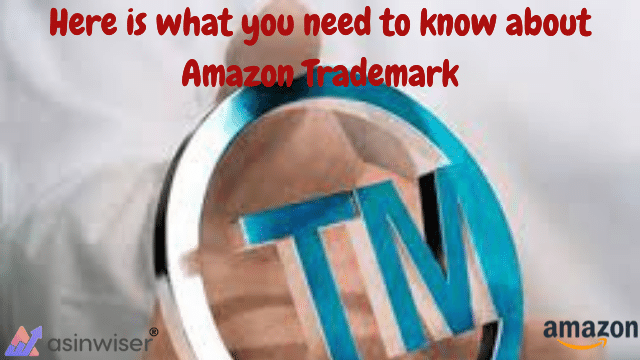
Here is what you need to know about Amazon Trademark
Amazon is the trendiest hub to sell your products and be a seller. Supposedly the next biggest thing that Amazon sellers have had to maintain is the theory of having to get a trademark. Being a seller entails a lot more than you think. There are so many things that need your attention and awareness on Amazon. Many sellers fail to understand every nitty-gritty of Amazon, hence it can be said that the trademark is indeed new territory.
Although earning a trademark comes with costs and takes several months to process. But your brand needs to have a trademark to avoid any defrauding.
Through this article, we will take you on the journey of trademarks.
What is a trademark?
A most common question which ought to arise is what is a trademark?
A trademark is a word, symbol or design, or combination of the same such as a brand name or logo that a business uses to recognize its products or services and to differentiate them from other businesses products and services.
A trademark owner protects a trademark by enlisting it with a country-specific trademark office, or with a cross-border office. Trademark protection is territorial by nature, i.e. the geographic scope of protection for trademarks is limited and relies on the place of registration.
In a few circumstances, a person or company might have trademark rights based on only the use of a mark in commerce, even though the mark was never registered under their name. Such rights are called unregistered trademarks and exist only under very restricted conditions.
What do you need to apply for a trademark?
To apply for a trademark you will need to do the following things:
• A legal business or you can register as an individual with an EIN code if you are just starting and haven’t registered an LLC or other business entity yet
• A logo that you wish to use
• A full legal name and address of the seller
• A copy of the product for an example.
• The date you started using your logo or shared it anywhere.
• Which International Class do you plan to use (or multiple classes – more on this later!)
What do trademarks protect?
In general, trademark law protects sellers of products and services from the misapplication of their trademarks by unauthorized third parties. In particular, where there is potential customer confusion about who offers, approves or is affiliated with that particular product or service.
A trademark owner can discontinue others from applying for a particular trademark:
(a) for products or services which are similar to those for which the owner has registered his mark
(b) for products or services that are similar to that of the registered mark if it is likely that customers could be confused even if the mark used is not identical but only similar; or
(c) if the owner’s mark has a reputation in the relevant domain and where the use of that same or a similar mark without due cause takes unfair advantage, then the unique character or the reputation of the owner’s mark.
Is the seller required permission to use a trademark?
Just for the reason that you are not the owner of a trademark does not of necessity mean that you cannot sell the right owner’s product. If the product is authentic, and not an unlawful import then you can use the trademark to market that specific product.
However, please keep in mind that the rights owner can prohibit the use of the mark if there exist legitimate reasons to oppose further commercialization of the goods, especially where the condition of the goods is changed or impaired after they have been put on the market.
Most other unauthorized uses of a trademark constitute an infringement; if you are unsure whether your use violates someone else’s trademark, you should consult a lawyer before listing on Amazon.
When can a seller use someone else’s trademark?
In general, the seller can use someone else’s trademark in the following situations:
1. While selling authentic products, a seller may use a trademark name to list those authentic products. Also, while using a trademark word in its ordinary dictionary, descriptive meaning.
2. When making statements about products compatible with a trademarked product make sure they are authentic.
3. If you want the compatibility of your product with a product of a different brand in the product title, build your product title as follows, taking also an account of Amazon Brand Name Policy. If you do not use this format to your product title, your listing may be removed as potentially trademark infringing.
4. It is important to assure that the products you are selling, and the content of your listings, do not violate a trademark or you could lose your selling privileges and face potential legal consequences.
Final Words
If you are a copyrights owner with a registered trademark, you are eligible to enrol your brand in the Amazon Brand Registry. Perhaps, make informed and strategic decisions. Customers, including search terms and more customer behaviour data reports, can help you to make smarter, faster business decisions.
We hope this helps.
If you are an online Amazon seller, then you must have an intelligent tool that will guide your business towards success by targeting the brand story, right keyword, products research, analyzing competitors, fba calculator and so much more. Get your ticket to success today!
- Tags: Amazon sellerstrademark
Share this:
Subscribe to Our Newsletter
Recent Post
- Top 13 Amazon Inventory Management Tools for FBA Sellers in 2023
- Asinwiser: The Ultimate OMSGuru Alternative for Amazon Sellers
- Repricer.com Alternative: Why Asinwiser is the Superior Choice for Amazon Sellers
- Aura Alternative: Why Asinwiser is the Superior Choice for Amazon Repricing
- Maximize Amazon Sales with Asinwiser: The Superior Amazon Repricer & Revenue Analytics Tool
